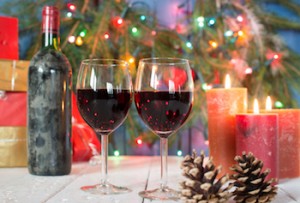Holiday Spirits: Holiday Wine Primer
The holiday season is here! This time of year brings parties, intimate dinners, and memorable evenings visiting with family and friends. Wine adds a festive note and cheer to any occasion. To help with your holiday planning, we’ve provided a list of the best varietals for the season along with recommendations of what dishes they complement best. Enjoy the festivities!
Pinot Noirs are an ideal choice for the holidays because they are so versatile. Fruit-forward versions are known for their notes of cherries, raspberries, and strawberries. Savory versions have earthy flavors and are often described in terms of their satiny texture. Pinot Noirs typically have low tannins, balanced acidity, and are medium-to-light body.
Suggested Food Pairings: Fruitier versions pair best with roasted chicken, pasta and risotto dishes, and salmon; savory versions pair well with duck and beef bourguignon.
Wines to Look For: France’s Burgundy region, Oregon’s Willamette Valley, California’s Russian River Valley and Carneros, New Zealand’s Central Otago region
*Tip: If selecting a bottle of wine to bring to a party or ordering a bottle to share at a restaurant, a Pinot Noir is a guaranteed crowd pleaser.
Riesling
Riesling has a reputation in the U.S. for being sweet, yet this varietal is commonly dry. Originating in Germany’s Rhine region, Rieslings are characterized by high acidity and aromas of apricot, nectarine, and apple.
Suggested Food Pairings: Full-bodied, dry versions pair nicely with light seafood dishes and some veal, poultry or pork dishes; moderately sweet versions pair with intense, spicy dishes; dessert versions pair with fruit tarts and cheese.
Wines to Look For: German Kabinetts, Eisweins, German Beerenausleses and Ausleses
*Tip: Avoid pairing a very sweet Riesling with chocolate or other overly-sweet desserts.
Cabernet Sauvignon
Big and bold, Cabernet Sauvignon is one of the world’s most popular wines and is typically full-bodied, high in tannins and moderately acidic. Aromatics include blackcurrant, cherry, vanilla, and cedar. This wine is often blended with other varietals but is fantastic on its own.
Suggested Food Pairings: Red meat dishes, ham and duck.
Wines to Look For: France’s Bordeaux region, California’s Napa Valley region, Italy’s Tuscany region, Australia’s Coonarwarra and Margaret regions
*Tip: A common misperception about Cabs is that they pair well with chocolate. In fact, the sugar and tannins in chocolate greatly detract from the wine’s taste.
Champagne and Sparkling Wines
The holidays are not complete without a bottle of bubbly. Remarkably diverse, these wines are best known for their carbonation, which is achieved through second fermentation. Champagne is produced in France, though there are many other delicious sparkling wines to try made in the same style.
Suggested Food Pairings: Oysters, fois gras, and asparagus dishes
Wines to Look for: France’s Champagne region, Italy’s Metodo Classico, Spain’s Cava, South Africa’s Cap Classique
*Tip: The sweetness level of champagne is described by the label name and ranges from dry (Extra Brut) to sweet (Doux).
Mix it Up with Something New
Traditional varietals are always a safe bet, but if you want to mix it up this season, here are some wines to try.
Viognier (pronounced VEE-ohn-yay) is characterized by intense aromatics of peaches, apricots, and violets. It is a full-bodied wine with deep golden color and a creamy texture, and is similar to Chardonnay.
Roussanne originates from the France’s Rhône Valley and is a floral, delicate wine with high acidity and notes of honey and apricots. This wine ages better than most whites and can be enjoyed as long as 15 years after bottling.
Txakoli (pronounced Chak-oh-lee) is a Spanish Basque wine that is clean, acidic, and complex. It is typically a white wine but is also available in red and rosé.




